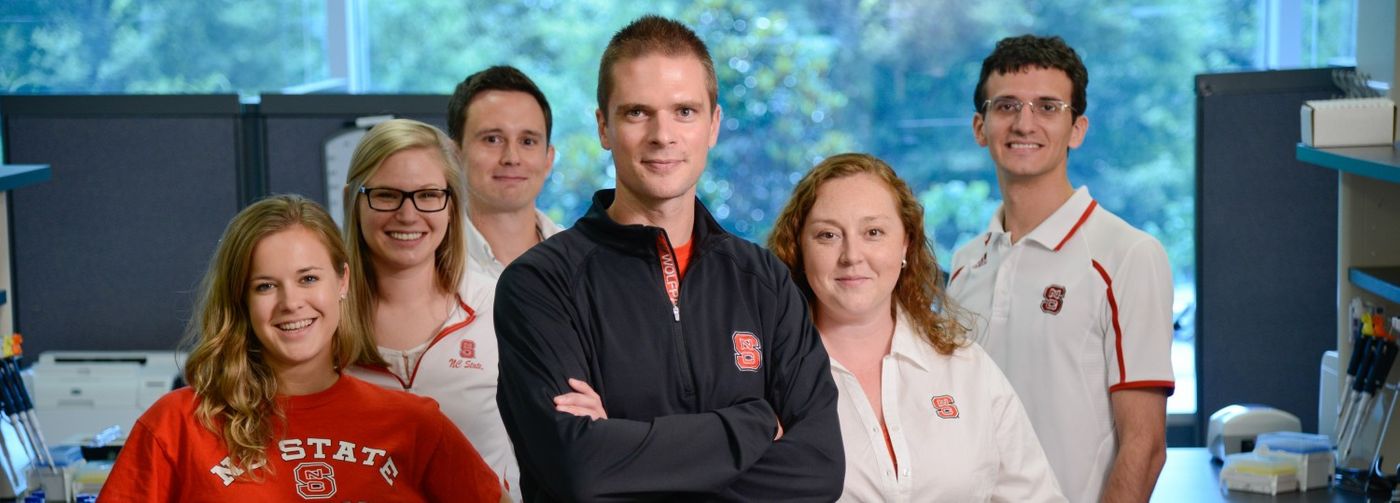The adaptive bacterial immune system known as CRISPR has taken biomedicine by storm in the years following its discovery. Before beginning his time at N.C. State University as an Associate Professor in food science, CRISPR pioneer and scientist Rodolphe Barrangou spent nearly a decade of his life dedicated to establishing and applying CRISPR technology in the lab and in the industry, and now Barrangou embarks on telling the world about what people call the “CRISPR Craze.”
Clustered Regularly Interspaced Short Palindromic Repeats
Barrangou aptly describes CRISPR as a “molecular scalpel to do molecular surgery.” Whether it is for gene therapy, plant breeding, or food production, CRISPR works because restriction enzymes recognize a short sequence motif in DNA, make a precise cut, which leads to DNA repair, and editing of the sequence at the site of cleavage.
“Imagine a phrase found in a book,” Barrangou explains. “Cut sentences every time you find that phrase on a page of a book, then expanding to an entire chapter, then throughout the whole book, and then a whole library.” This is how he describes the power of CRISPR programmable restriction enzymes. Like a library with hundreds or thousands of books, the human genome contains more than three billion letters. CRISPR’s molecular scalpel searches the entire genome for a specific motif, and every time it finds that sequence it makes a cut, eventually leading to re-writing (editing) the sequence at the site of interest.
“You can program CRISPR to recognize a very unique sequence in the very large, extensive, and diverse book of life,” Barrangou says. “And it cuts there. That’s why CRISPR restriction enzymes are molecular scalpels, and that’s why the process is molecular surgery.”
Different Systems of CRISPR
CRISPR technology is derived from bacteria, which evolved these adaptive immune systems for the same reasons that humans did: for protection from invasive viruses in nature. Like the viruses that infect humans, bacteria have to protect themselves from viruses containing different kinds of nucleic acids as their genetic material. Different recognition methods vary in bacterial CRISPR systems depending on the target nucleic acid type, leading to a collection of protective tools in bacteria that Barrangou calls a “genetic arsenal.”
Plus, Barrangou explains, bacteria can also obtain genes from other bacteria via mechanisms like lateral gene transfer. “CRISPR helps them maintain the homeostasis of their genome when this happens,” he says. “When they encounter foreign DNA that they want to fight, CRISPR ensures the genes aren’t integrated.”
Meanwhile, In North Carolina
The applications for CRISPR in genome engineering are nearly endless, and researchers all over the world now have labs dedicated to enhancing CRISPR systems and finding ways to apply them to multiple aspects of science.
At Barrangou’s
CRISPR lab in Raleigh, North Carolina, a task force of 14 made up of staff, students, and post-docs collaborate on several projects of their own. Just to name a few, Barrangou’s team is working on:
- Developing CRISPR-Cas systems that cleave more efficiently.
- Improving specificity of the “molecular scalpel” – preventing unintentional cuts in a genetic sentence with similar phrasing to the target sequence
- Enhancing the delivery of CRISPR-Cas systems into the genome
The applications in bacteria span vaccination of dairy cultures against phages, the development of enhanced health-promoting probiotics, and the use of self-targeting CRISPRs as programmable antimicrobials. What’s amazing is that while hundreds of scientists are busy tinkering with known CRISPR systems, there are undoubtedly even more CRISPR systems left to be discovered in nature.
“There are even some that have been discovered that scientists haven’t been able to fully understand yet,” Barrangou says. “New systems are expected to be uncovered over time; bacteria are always evolving.”
Amidst all of the new scientific findings, awards received, and questions raised about the future of genome engineering, Barrangou continues to go on the road to “spread the gospel of CRISPR:” in museums, public arenas, business settings, for students and career development, and outreach events for people of all ages. The very first published report of CRISPR-related clustered repeats in adaptive bacterial immune systems came out back in 1987, but the discoveries are far from over. In the words of Barrangou: “the CRISPR Craze is everywhere,” and it continues to spread.
Source: Interview with Rodolphe Barrangou
Images: Leaders in Pharmaceutical Business Intelligence, Business Insider, N.C. State University CRISPR Lab



![Everything You Need To Know About NGS [eBook]](https://d3bkbkx82g74b8.cloudfront.net/eyJidWNrZXQiOiJsYWJyb290cy1pbWFnZXMiLCJrZXkiOiJjb250ZW50X2FydGljbGVfcHJvZmlsZV9pbWFnZV9mNTM1ZjIyYzA5MDE5ZmNmMWU5NmI0ZDc4NWU2MzdiZTZlN2I5ZDk5XzE4NDUuanBnIiwiZWRpdHMiOnsidG9Gb3JtYXQiOiJqcGciLCJyZXNpemUiOnsid2lkdGgiOjcwMCwiaGVpZ2h0IjozNTAsImZpdCI6ImNvdmVyIiwicG9zaXRpb24iOiJjZW50ZXIiLCJiYWNrZ3JvdW5kIjoiI2ZmZiJ9LCJmbGF0dGVuIjp7ImJhY2tncm91bmQiOiIjZmZmIn19fQ==)






